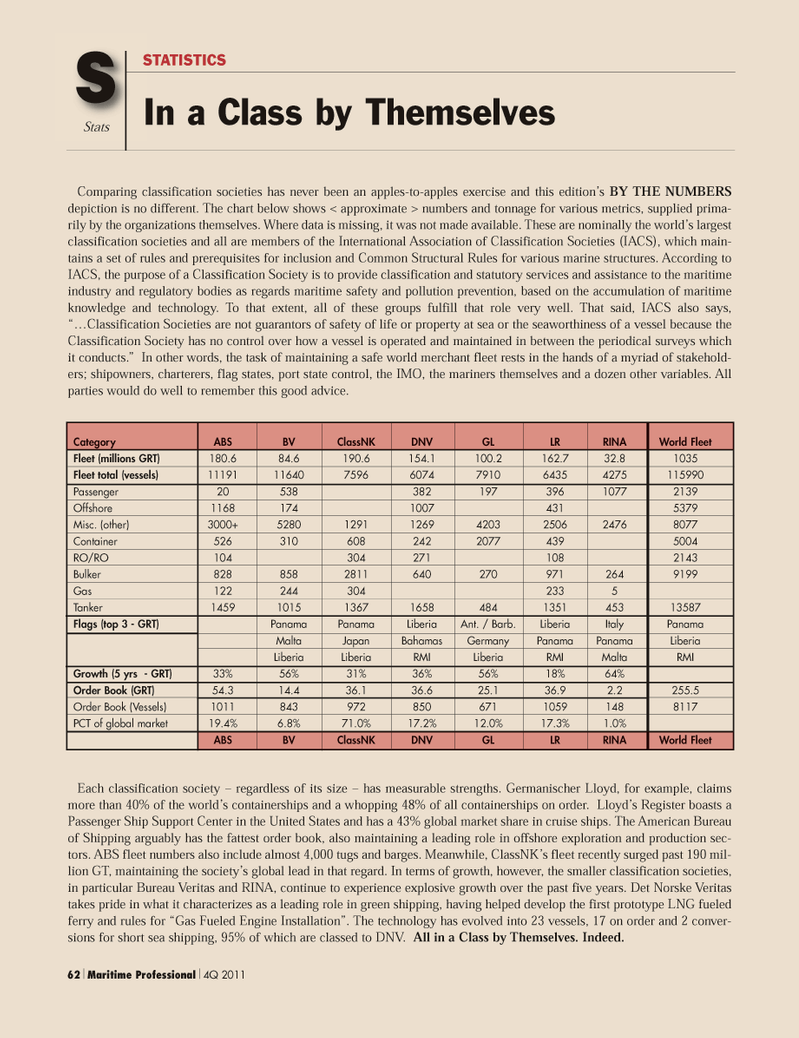
Page 62: of Maritime Logistics Professional Magazine (Q4 2011)
Classification
Read this page in Pdf, Flash or Html5 edition of Q4 2011 Maritime Logistics Professional Magazine
62 Maritime Professional 4Q 2011Comparing classification societies has never been an apples-to-apples exercise and this edition?s BY THE NUMBERS depiction is no different. The chart below shows < approximate > numbers and tonnage for various metrics, supplied prima- rily by the organizations themselves. Where data is missing, it was not made available. These are nominally the world?s largest classification societies and all are members of the International Association of Classification Societies (IACS), which main- tains a set of rules and prerequisites for inclusion and Common Structural Rules for various marine structures. According to IACS, the purpose of a Classification Society is to provide classification and statutory services and assistance to the maritim eindustry and regulatory bodies as regards maritime safety and pollution prevention, based on the accumulation of maritime knowledge and technology. To that extent, all of these groups fulfill that role very well. That said, IACS also says, ??Classification Societies are not guarantors of safety of life or property at sea or the seaworthiness of a vessel because the Classification Society has no control over how a vessel is operated and maintained in between the periodical surveys which it conducts.? In other words, the task of maintaining a safe world merchant fleet rests in the hands of a myriad of stakehold- ers; shipowners, charterers, flag states, port state control, the IMO, the mariners themselves and a dozen other variables. All parties would do well to remember this good advice. Each classification society ? regardless of its size ? has measurable strengths. Germanischer Lloyd, for example, claims more than 40% of the world?s containerships and a whopping 48% of all containerships on order. Lloyd?s Register boasts a Passenger Ship Support Center in the United States and has a 43% global market share in cruise ships. The American Bureau of Shipping arguably has the fattest order book, also maintaining a leading role in offshore exploration and production sec- tors. ABS fleet numbers also include almost 4,000 tugs and barges. Meanwhile, ClassNK?s fleet recently surged past 190 mil- lion GT, maintaining the society?s global lead in that regard. In terms of growth, however, the smaller classification societie s,in particular Bureau Veritas and RINA, continue to experience explosive growth over the past five years. Det Norske Veritas takes pride in what it characterizes as a leading role in green shipping, having helped develop the first prototype LNG fueled ferry and rules for ?Gas Fueled Engine Installation?. The technology has evolved into 23 vessels, 17 on order and 2 conver- sions for short sea shipping, 95% of which are classed to DNV. All in a Class by Themselves. Indeed. SStatsIn a Class by ThemselvesSTATISTICS Category ABSBVClassNKDNVGL LRRINAWorld Fleet Fleet (millions GRT) 180.684.6190.6154.1100.2162.732.81035 Fleet total (vessels)11191 1164075966074791064354275115990 Passenger20538 38219739610772139 Offshore 1168174 10074315379Misc. (other)3000+5280129112694203250624768077 Container5263106082422077439 5004RO/RO104304271 1082143Bulker82885828116402709712649199 Gas122244304 2335 Tanker 1459101513671658484135145313587 Flags (top 3 - GRT) PanamaPanamaLiberiaAnt. / Barb.LiberiaItalyPanama MaltaJapanBahamasGermanyPanamaPanamaLiberia LiberiaLiberiaRMILiberiaRMIMaltaRMI Growth (5 yrs - GRT) 33%56%31%36%56%18%64% Order Book (GRT) 54.314.436.136.625.136.92.2255.5 Order Book (Vessels)101184397285067110591488117 PCT of global market19.4% 6.8% 71.0%17.2%12.0%17.3%1.0% ABSBVClassNKDNVGL LRRINAWorld Fleet MP #4 (50-64):MP Layouts 11/9/2011 9:24 AM Page 62

 61
61

 63
63
